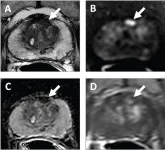(Press-News.org) New research published in Diabetologia (the journal of the European Association for the Study of Diabetes [EASD]) shows that morning and afternoon physical activity are associated with a lower risk of developing type 2 diabetes across all population levels of education and income, but found no statistically significant association between evening physical activity and risk type 2 diabetes. The study is by Dr Caiwei Tian, Harvard University, Cambridge, MA, USA, and Dr Chirag Patel, Harvard Medical School, Boston, MA. and colleagues.
Physical activity is a preventive factor for type 2 diabetes, but its timing and consistency (in contrast with overall sum of physical activity) has been relatively unexplored. Accelerometer-based devices that measure physical activity provide a new opportunity to objectively measure behaviour throughout the day and week. It has been shown that midday–afternoon but not evening physical activity is associated with a lower risk of mortality compared with morning physical activity, but the relationship with type 2 diabetes remains understudied. In this new study, the authors analysed the relationship between morning, afternoon, or evening physical activity and consistency (routine) and risk of type 2 diabetes.
A cohort of 93,095 UK Biobank participants (mean age 62 years) without a history of type 2 diabetes wore a wrist-worn accelerometer for 1 week. The authors converted accelerometer information to estimate metabolic equivalent of task (MET) (a common measure of physical activity), summing MET-hours of total physical activity. MET-hour physical activity captures all types of activity undertaken by an individual throughout the day and measured with the accelerometer, including chores, walking, and vigorous activity. The authors measured completed METs within three time segments (morning, afternoon, and evening), divided as 06:00–12:00 hours (morning); 12:00–18:00 hours (afternoon); and 18:00–24:00 hours (evening).
The authors quantified the consistency of physical activity by analysing the variance, or difference of each person’s activity from their own personal average. Those with smaller deviations were more consistent and vice versa. The authors also considered the intensity of exercise: moderate-to-vigorous physical activity (MVPA) and vigorous physical activity (VPA) in association with type 2 diabetes incidence.
The authors observed protective associations of physical activity, with each 1-unit increase in MET being associated with a 10% and 9% reduction in risk of type 2 diabetes in the morning and afternoon, respectively. However, there was no statistically significant association between evening physical activity and risk of type 2 diabetes.
The relationship with morning and afternoon physical activity was largely linear, meaning that those people with more MET-h completed had a much lower risk of developing type 2 diabetes than those with less (10% / 9% per MET-h, for morning and afternoon respectively).
The authors thought that lifestyle factors, such as amount of sleep and dietary intake, would influence the amount of physical activity in the morning, afternoon, and evening undertaken, and therefore the role activity has in diabetes risk. To address how these factors influence physical activity, the authors considered these factors in their analytic models. They found that when adjusting for lifestyle factors, associations for MET-hours with different times of day became more precise.
Consistency of MET-measured physical activity was not associated with type 2 diabetes; but intensity was – both MVPA and VPA were associated with decreased risk for type 2 diabetes at all times of the day. The authors say their study is the first report on the effect of consistency of activity, and explain: “The consistency or routine of physical activity was not strongly associated with type 2 diabetes. In other words, individuals who exercise a smaller amount of time more frequently are at no lesser risk for diabetes than individuals who exercise the same total amount, but with less of a routine.”
Unlike previous studies, the authors highlight that one of the strengths of this new research is that they used the MET h as the objective physical activity measurement to take all daily activities into account. Their results were also statistically significant after adjusting for other lifestyle variables including sleep, diet, education and income.
The authors conclude: “Our findings support that total physical activity but not its consistency over the week may be an important factor impacting type 2 diabetes risk. The timing of activity may play a role in mitigation of diabetes risk.”
They add: “Our study showed an association with diabetes risk between morning and afternoon versus evening physical activity. The findings also suggest it is helpful to include some higher intensity activity to help reduce the risk of developing diabetes and other cardiovascular disease.”
END
Study shows morning and afternoon slightly better than evening physical activity for diabetes prevention
People who exercise, as measured by a wrist-worn accelerometer, a smaller amount of time more frequently are at no lesser risk for diabetes than individuals who exercise the same total amount, but with less of a routine
2023-09-21
ELSE PRESS RELEASES FROM THIS DATE:
Monkeys cause a stink in response to human noise
2023-09-21
New research has found that monkeys increase their use of scent markings to compensate for human noise pollution.
Pied tamarins (Saguinus bicolor) use both vocal calls and scent markings to communicate, and the new study – published in the journal Ethology Ecology & Evolution – is the first to investigate how primates change their communication strategies in response to noise pollution.
The pied tamarin has an extremely narrow geographic range in central Brazil, much of which now lies within the city of ...
Prostate cancer upgrade, downgrade rates in PI-RADS 2.0 versus 2.1
2023-09-20
Leesburg, VA, September 20, 2023—According to an accepted manuscript published in the American Journal of Roentgenology (AJR), upgrade and downgrade rates from targeted biopsy to radical prostatectomy were not significantly different between patients whose MRI examinations were clinically interpreted using PI-RADS Version v2.0 or v2.1.
“Implementation of the most recent PI-RADS update did not improve the incongruence in prostate cancer grade assessment between targeted biopsy and surgery,” wrote corresponding author Baris Turkbey, MD, from the Molecular Imaging Branch ...
New recycling method fights plastic waste
2023-09-20
Almost 80% of plastic in the waste stream ends up in landfills or accumulates in the environment. Oak Ridge National Laboratory scientists have developed a technology that converts a conventionally unrecyclable mixture of plastic waste into useful chemicals, presenting a new strategy in the toolkit to combat global plastic waste.
The technology, invented by ORNL’s Tomonori Saito and former postdoctoral researcher Md Arifuzzaman, uses an exceptionally efficient organocatalyst that allows selective deconstruction ...
Low follow-up kidney testing after hospital discharge with moderate to severe AKI
2023-09-20
A study of Canadian hospitalizations from 2007-2019 show that over 75% of patients with moderate to severe acute kidney injury (AKI) do not get appropriate follow-up kidney health testing after hospital discharge.
A study in Alberta, Canada, examined care received by over 20,000 hospitalized with AKI during hospitalization and after discharge between 2009 and 2017. The results, recently published in the American Journal of Kidney Diseases (AJKD), showed that a low proportion of patients with moderate to severe AKI were seen by a kidney specialist ...
Unzipping mRNA rallies plant cells to fight infection
2023-09-20
DURHAM, N.C. -- Living things from bacteria to plants to humans must constantly adjust the chemical soup of proteins -- the workhorse molecules of life -- inside their cells to adapt to stress or changing conditions, such as when nutrients are scarce, or when a pathogen attacks.
Now, researchers have identified a previously unknown molecular mechanism that helps explain how they do it.
Studying a spindly plant called Arabidopsis thaliana, a Duke University-led team discovered short snippets of folded RNA that, under normal conditions, keep levels of defense proteins low to avoid harming the plants themselves. But when the plants detect a pathogen, these folded RNA structures ...
New research findings: Understanding the sex life of coral gives hope of clawing it back from the path to extinction
2023-09-20
For the first time, scientists have mapped the reproductive strategies and life cycle of an endangered coral species, offering hope it can be clawed back from the path to extinction.
The purple cauliflower soft coral, Dendronephthya australis, is endemic to south-eastern Australia, with the largest populations historically found in the Port Stephens estuary in New South Wales. It is one of the 100 priority species on the Federal Government’s Threatened Species Strategy.
Not only is the future ...
New model for in vitro production of human brown fat cells lays groundwork for obesity, diabetes cell therapy
2023-09-20
Brown adipocytes are specialized cells that can use energy to produce heat. This property makes them attractive tools for the treatment of diseases like obesity and type 2 diabetes. Until recently, this therapeutic potential was constrained by limited understanding of how brown adipocyte tissue (BAT) develops from precursors.
A team led by investigators at Brigham and Women’s Hospital, a founding member of the Mass General Brigham healthcare system, identified a set of cellular signaling cues that lead up to brown ...
College athletes experience worse post-injury outcomes for concussions suffered outside of sports
2023-09-20
Philadelphia, September 20, 2023 – Researchers from Children’s Hospital of Philadelphia (CHOP) found that college athletes had worse post-injury outcomes related to concussions they experienced outside of sports than those they experienced while playing sports. Additionally, female athletes who sustained their injury outside of sports had more severe symptoms and more days in sports lost to injury relative to male athletes. These findings suggest the need for improved concussion recognition, reporting, and monitoring outside of sports.
The study was recently published online by the Journal of Athletic Training.
Concussions have the potential to ...
CHOP researchers develop novel method using MRI to study diseases modeled in zebrafish
2023-09-20
Philadelphia, September 20, 2023 – Zebrafish have revolutionized research into a wide variety of rare and complex genetic diseases. In early development stages, their transparent bodies allow researchers to more easily study tissues and organs. However, studying organ-level defects in adult zebrafish presents a variety of challenges that prevent researchers from studying them at a microscopic level.
In a new study, researchers from Children’s Hospital of Philadelphia (CHOP) have developed a noninvasive method for conducting magnetic resonance imaging (MRI) in adult zebrafish. ...
15 top journalists earn aging-focused reporting fellowships
2023-09-20
The Gerontological Society of America (GSA) and the Journalists Network on Generations are welcoming 15 distinguished reporters for the next cohort of the Journalists in Aging Fellows Program, now in its 14th year.
They represent a wide range of general audience, ethnic, and community media outlets, including local and national publications. This year’s group brings the program’s total number of participating reporters to 232. The new fellows were chosen — by a panel of gerontological and editorial professionals — based on their proposals for ...
LAST 30 PRESS RELEASES:
Quantum ‘alchemy’ made feasible with excitons
‘Revoice’ device gives stroke patients their voice back
USF-led study: AI helps reveal global surge in floating algae
New method predicts asthma attacks up to five years in advance
Researchers publish first ever structural engineering manual for bamboo
National poll: Less than half of parents say swearing is never OK for kids
Decades of suffering: Long-term mental health outcomes of Kurdish chemical gas attacks
Interactional dynamics of self-assessment and advice in peer reflection on microteaching
When aging affects the young: Revealing the weight of caregiving on teenagers
Can Canada’s health systems handle increased demand during FIFA World Cup?
Autistic and non-autistic faces may “speak a different language” when expressing emotion
No clear evidence that cannabis-based medicines relieve chronic nerve pain
Pioneering second-order nonlinear vibrational nanoscopy for interfacial molecular systems beyond the diffraction limit
Bottleneck in hydrogen distribution jeopardises billions in clean energy
Lung cancer death rates among women in Europe are finally levelling off
Scientists trace microplastics in fertilizer from fields to the beach
The Lancet Obstetrics, Gynecology, & Women’s Health: Taking paracetamol during pregnancy does not increase risk of autism, ADHD or intellectual disabilities, confirms new gold-standard evidence review
Taking paracetamol during pregnancy does not increase risk of autism, ADHD or intellectual disabilities
Harm reduction vending machines in New York State expand access to overdose treatment and drug test strips, UB studies confirm
University of Phoenix releases white paper on Credit for Prior Learning as a catalyst for internal mobility and retention
Canada losing track of salmon health as climate and industrial threats mount
Molecular sieve-confined Pt-FeOx catalysts achieve highly efficient reversible hydrogen cycle of methylcyclohexane-toluene
Investment in farm productivity tools key to reducing greenhouse gas
New review highlights electrochemical pathways to recover uranium from wastewater and seawater
Hidden pollutants in shale gas development raise environmental concerns, new review finds
Discarded cigarette butts transformed into high performance energy storage materials
Researchers highlight role of alternative RNA splicing in schizophrenia
NTU Singapore scientists find new way to disarm antibiotic-resistant bacteria and restore healing in chronic wounds
Research suggests nationwide racial bias in media reporting on gun violence
Revealing the cell’s nanocourier at work
[Press-News.org] Study shows morning and afternoon slightly better than evening physical activity for diabetes preventionPeople who exercise, as measured by a wrist-worn accelerometer, a smaller amount of time more frequently are at no lesser risk for diabetes than individuals who exercise the same total amount, but with less of a routine



